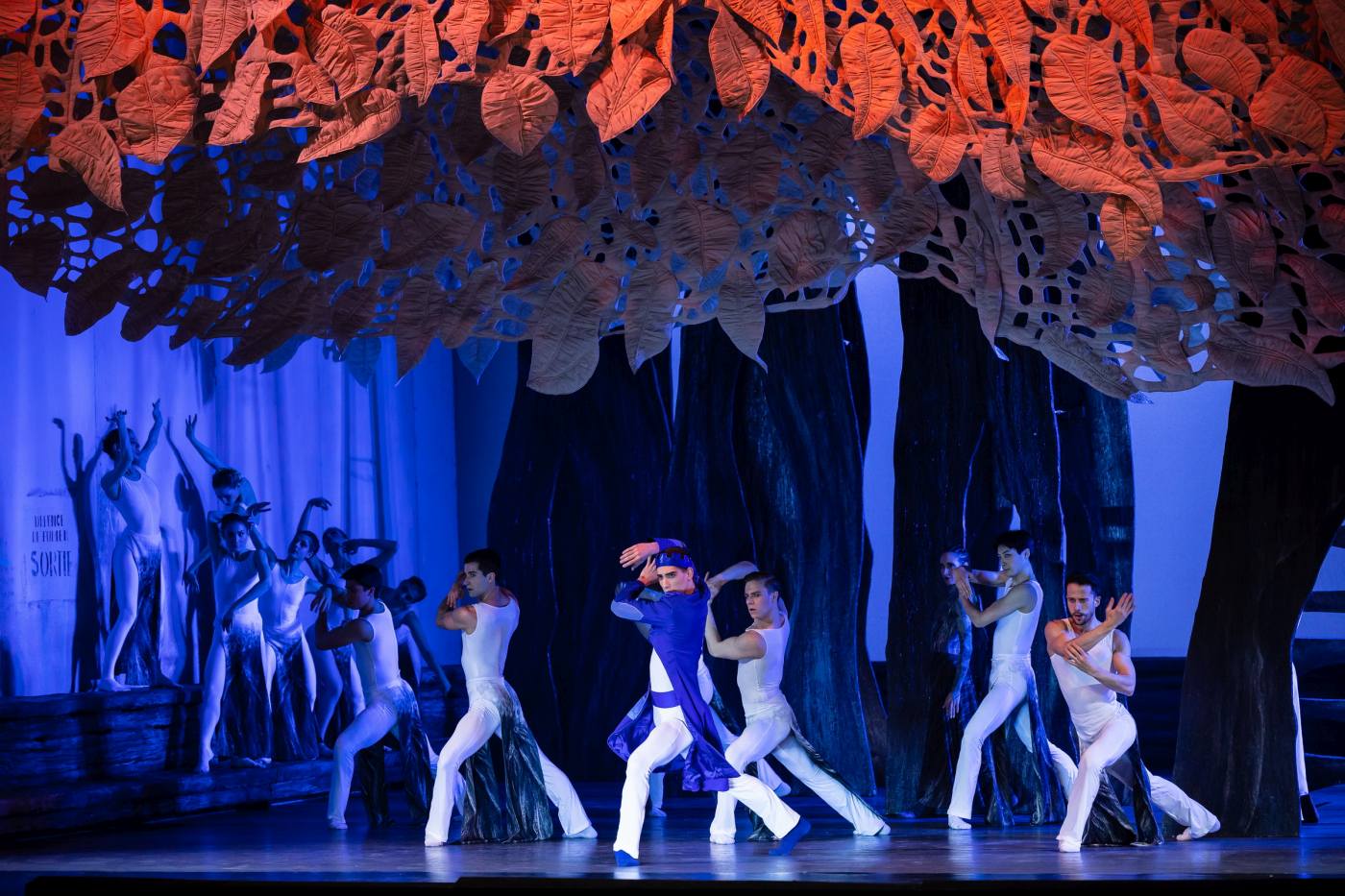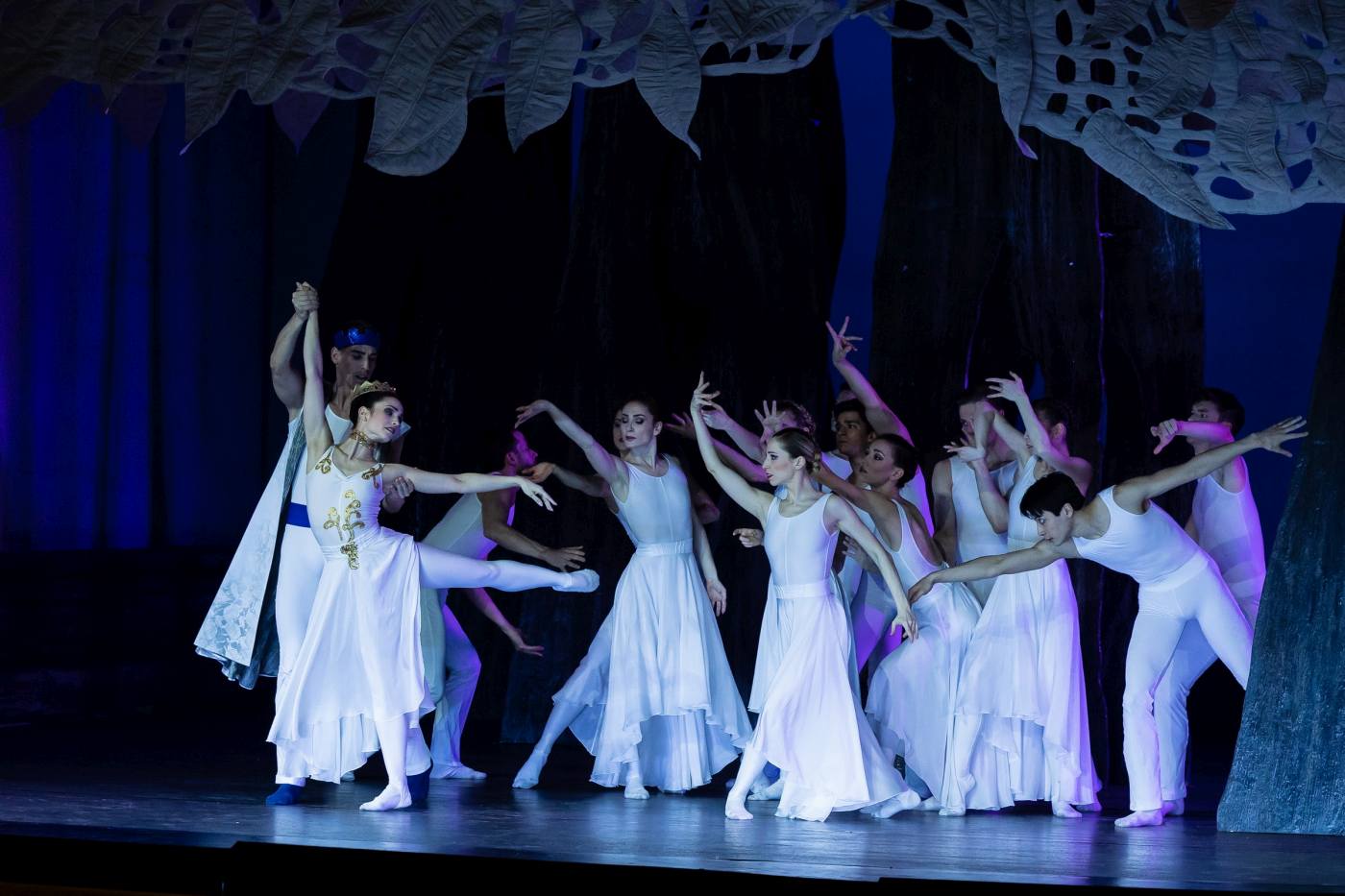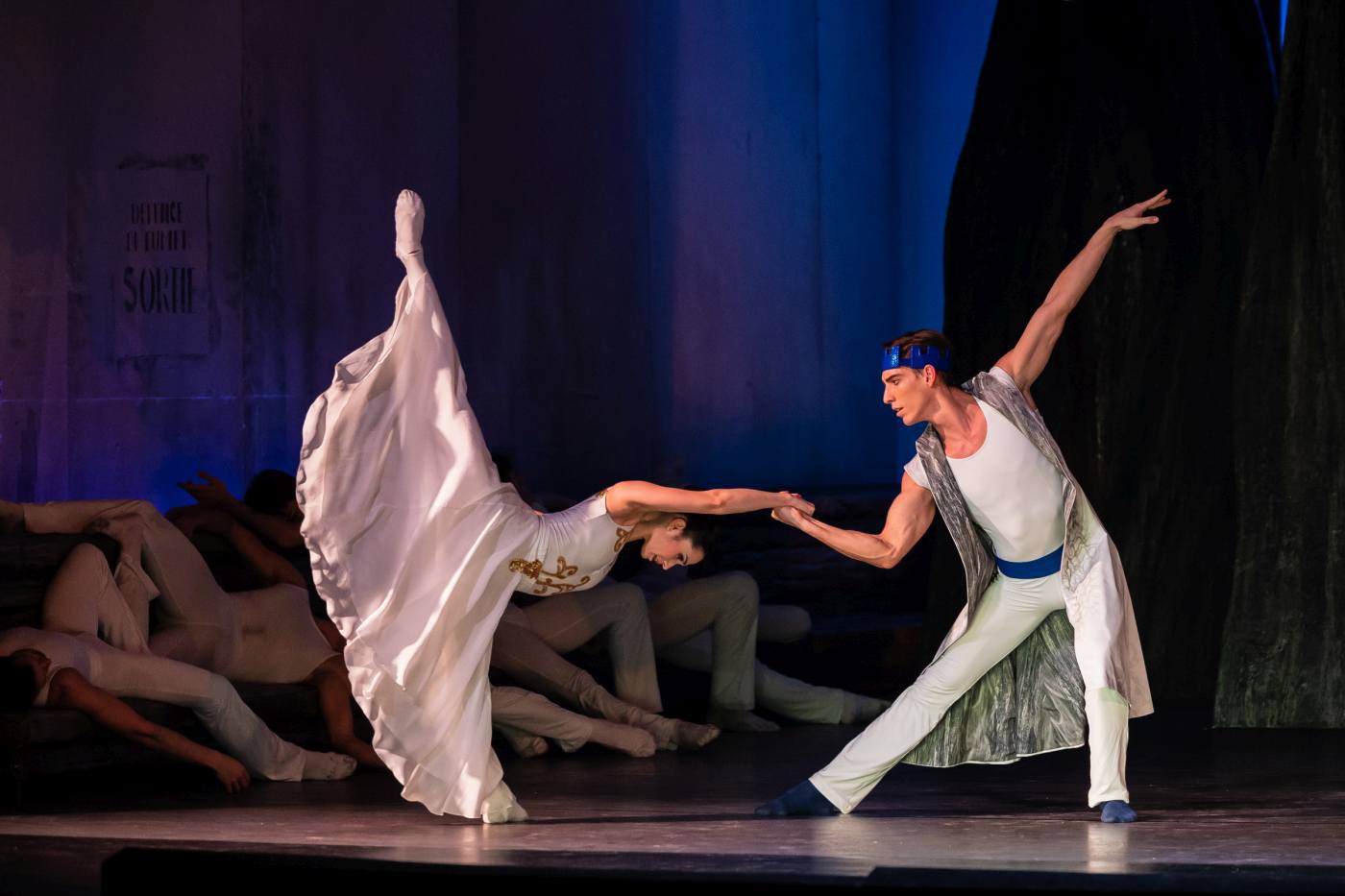“The Wooden Prince” / “Bluebeard’s Castle”
Hungarian National Ballet / Hungarian National Opera
Hungarian State Opera
Budapest, Hungary
February 11, 2023
by Ilona Landgraf
Copyright © 2023 by Ilona Landgraf
“Young Béla, you have no business composing music.”
 Such was the spirit and style of the reviews that had been pre-fabricated by the Budapest press prior to the premiere of Béla Bartók’s pantomime ballet “The Wooden Prince” in May 1917. Instead, the piece was an enormous success – prompting a busy night of rewrites for the journalists. It marked Bartók’s Hungarian breakthrough – a shift in the attitude of his home audience towards his work. As a result, the opera house finally agreed to stage Bartók’s Symbolist opera “Bluebeard’s Castle” in 1918 after seven years’ waiting for a premiere. Over the last century, versions of both works have remained in constant rotation in the repertoire of the Hungarian National Opera. I saw the premiere of a new work – Velekei’s “Wooden Prince” – presented in a double bill alongside a 2018 staging of “Bluebeard’s Castle”.
Such was the spirit and style of the reviews that had been pre-fabricated by the Budapest press prior to the premiere of Béla Bartók’s pantomime ballet “The Wooden Prince” in May 1917. Instead, the piece was an enormous success – prompting a busy night of rewrites for the journalists. It marked Bartók’s Hungarian breakthrough – a shift in the attitude of his home audience towards his work. As a result, the opera house finally agreed to stage Bartók’s Symbolist opera “Bluebeard’s Castle” in 1918 after seven years’ waiting for a premiere. Over the last century, versions of both works have remained in constant rotation in the repertoire of the Hungarian National Opera. I saw the premiere of a new work – Velekei’s “Wooden Prince” – presented in a double bill alongside a 2018 staging of “Bluebeard’s Castle”.
 The Velekei in question is László Velekei, director of the Ballet Company of Győr / Hungary, whose new choreography for “The Wooden Prince” marked his first collaboration with the National Ballet. Velekei slightly tweaked Béla Balázs’s original libretto, but remained true to the source. We begin with a prince and a princess living in separate castles on either side of a thick forest. In fairytales, princes and princesses usually become lovers. In this tale, though, the forest’s witch is hoping to bag the prince herself, and thus has a keen interest in keeping the pair apart. Though the prince is indeed attracted by the fairy witch, he is also disinclined to engage – but his reluctance is soon overpowered by her magic. I’m not sure why she chooses to create a wooden version of him that complies to her desires – perhaps to showcase her might? When the princess catches sight of the wooden prince, sparks fly between them right away. Their blossoming romance brings the real prince back onstage, but from the moment he re-appears, his wooden counterpart wilts. The princess sadly watches as the fairy witch throws herself at the real royal and declares him king of the forest.
The Velekei in question is László Velekei, director of the Ballet Company of Győr / Hungary, whose new choreography for “The Wooden Prince” marked his first collaboration with the National Ballet. Velekei slightly tweaked Béla Balázs’s original libretto, but remained true to the source. We begin with a prince and a princess living in separate castles on either side of a thick forest. In fairytales, princes and princesses usually become lovers. In this tale, though, the forest’s witch is hoping to bag the prince herself, and thus has a keen interest in keeping the pair apart. Though the prince is indeed attracted by the fairy witch, he is also disinclined to engage – but his reluctance is soon overpowered by her magic. I’m not sure why she chooses to create a wooden version of him that complies to her desires – perhaps to showcase her might? When the princess catches sight of the wooden prince, sparks fly between them right away. Their blossoming romance brings the real prince back onstage, but from the moment he re-appears, his wooden counterpart wilts. The princess sadly watches as the fairy witch throws herself at the real royal and declares him king of the forest.

 Whatever shall be, shall be, though – and nature forcefully intervenes, stripping the princess of her royal vestment. Now a commoner, she meets the prince face-to-face. When she takes off his crown, each recognizes the true essence of the other and happily unite.
Whatever shall be, shall be, though – and nature forcefully intervenes, stripping the princess of her royal vestment. Now a commoner, she meets the prince face-to-face. When she takes off his crown, each recognizes the true essence of the other and happily unite.
Velekei chose to characterize the fairy witch (Jessica Carulla Leon) as a scheming, powerful woman who rigorously demands that others submit to her desires. Her wishes are paramount, and the forces of nature (portrayed by a corps of twelve wearing simple gray-white outfits designed by Nóra Romámyi) are simply the vessels of their fulfillment.

 She sails in on the back of the prince (the tall Ármin Balázsi Gergő – an ideal casting), her body snuggling to him like a kitten. Her legs cling around his chest while her arms embrace (or nearly strangle) his neck. The forces of nature obediently glue the prince to the ground and then thrust him into the air. They surge like rising waters, undulate like tree branches in the wind, massing together and assaulting on command.
She sails in on the back of the prince (the tall Ármin Balázsi Gergő – an ideal casting), her body snuggling to him like a kitten. Her legs cling around his chest while her arms embrace (or nearly strangle) his neck. The forces of nature obediently glue the prince to the ground and then thrust him into the air. They surge like rising waters, undulate like tree branches in the wind, massing together and assaulting on command.
The princess (Lili Felméry) is a carefree royal – a bit childish, a bit pretentious, a bit too sure of herself. As she gradually matures, she doffs first her yellow satin skirt and the golden top (revealing a modest white dress with golden embroidery) and later loses her crown and jewelry.

 The most heart-warming figure is the wooden prince (András Rónai) – his eyes fill with pure rapture when he spots the princess and tries to impress her like a preening bird. His robotic jerks gained jaunty fluidity; joy fueled his every move. I couldn’t help but sympathize with him when he lost his agility, shuffling offstage like an immobile old man.
The most heart-warming figure is the wooden prince (András Rónai) – his eyes fill with pure rapture when he spots the princess and tries to impress her like a preening bird. His robotic jerks gained jaunty fluidity; joy fueled his every move. I couldn’t help but sympathize with him when he lost his agility, shuffling offstage like an immobile old man.
Set designer Rózsa István used the half-vault that his colleague Steffen Aarfing had already created for “Bluebeard’s Castle” as a frame for the witch’s forest. Sturdy tree trunks offered her places to hide. Tamás Pillinger’s lighting shifted and played in the wide white treetops.
 For “Bluebeard’s Castle”, the half-vault was emptied of trees and turned into a painter’s spacious attic atelier. In Danish director Kasper Holten’s interpretation, Bluebeard is an artist and Judith is his longtime wife. Holten dropped the prologue, and so the first somber notes of Bartók’s music reaffirm what the first moments of silence had already indicated: this is an unhappy couple. Bluebeard (Gábor Bretz), lying in a makeshift bed of stacked pallets, seems grumpy; Judith (Szilvia Vörös) sits wearily on the edge of the bed, her gray striped pajamas reminiscent of a convict’s uniform. The seven doors featured in the Bluebeard fairytale are nowhere to be seen. Indeed, a staircase descends through the floor at the back of the stage (it slipped my attention until the end) which Judith runs down as she attempts to escape. It’s an emergency exit, though, not an entrance to a secret chamber. The two large roof windows that bath the room in light seem confusing as well. This atelier is a bit messy (and well-stocked with alcohol), but in no way justifies Judith’s complaints about an “icy, dark, and gloomy” castle.
For “Bluebeard’s Castle”, the half-vault was emptied of trees and turned into a painter’s spacious attic atelier. In Danish director Kasper Holten’s interpretation, Bluebeard is an artist and Judith is his longtime wife. Holten dropped the prologue, and so the first somber notes of Bartók’s music reaffirm what the first moments of silence had already indicated: this is an unhappy couple. Bluebeard (Gábor Bretz), lying in a makeshift bed of stacked pallets, seems grumpy; Judith (Szilvia Vörös) sits wearily on the edge of the bed, her gray striped pajamas reminiscent of a convict’s uniform. The seven doors featured in the Bluebeard fairytale are nowhere to be seen. Indeed, a staircase descends through the floor at the back of the stage (it slipped my attention until the end) which Judith runs down as she attempts to escape. It’s an emergency exit, though, not an entrance to a secret chamber. The two large roof windows that bath the room in light seem confusing as well. This atelier is a bit messy (and well-stocked with alcohol), but in no way justifies Judith’s complaints about an “icy, dark, and gloomy” castle.

 What we’re about to witness isn’t a word-for-word narration of the gothic Maiden-killer story that Charles Perrault penned in 1697. Aarfing instead zoomed in on the meltdown of a relationship, provoked by Judith’s relentless probing into Bluebeard’s soul. He reluctantly reveals that creating art tortures him (the torture chamber) and that alcohol helps him to struggle through (the armory). His paintings (among them a nude portrait of a young couple) represent his treasury; a green dress with floral patterns worn by the young Judith helps him recall happier days (the hidden garden). Despite the fragile energy in the room Judith insists on unlocking the fifth door: the kingdom, praising Bluebeard’s “fair and spacious country”. By then, something has cracked inside her husband, and he grabs his paintings and sets them aflame. Paint tubes and brushes are trashed, too.
What we’re about to witness isn’t a word-for-word narration of the gothic Maiden-killer story that Charles Perrault penned in 1697. Aarfing instead zoomed in on the meltdown of a relationship, provoked by Judith’s relentless probing into Bluebeard’s soul. He reluctantly reveals that creating art tortures him (the torture chamber) and that alcohol helps him to struggle through (the armory). His paintings (among them a nude portrait of a young couple) represent his treasury; a green dress with floral patterns worn by the young Judith helps him recall happier days (the hidden garden). Despite the fragile energy in the room Judith insists on unlocking the fifth door: the kingdom, praising Bluebeard’s “fair and spacious country”. By then, something has cracked inside her husband, and he grabs his paintings and sets them aflame. Paint tubes and brushes are trashed, too.
 Suddenly, cold blue lighting casts a chill upon the atelier. Though Judith demands love and Bluebeard asks for kisses, the distance between them couldn’t be larger. The music takes a dangerous turn as Judith presses for the keys to the remaining doors. Behind the sixth is the pool of tears that Bluebeard has shed. There’s one final secret left – the wives – and though Bluebeard begs Judith to stop, she can’t – or doesn’t want to. “Tell me who you loved before me,” she demands, rummaging through his personal letters and the messages on his smartphone. That’s the final stroke. Though Bluebeard holds a mirror in front of his wife’s face and reassures her that she’s the only woman he has loved, their love has died. Judith, thoroughly distraught, runs down the staircase – and I was unsure whether she would return. Though she did, the relationship was beyond rescuing.
Suddenly, cold blue lighting casts a chill upon the atelier. Though Judith demands love and Bluebeard asks for kisses, the distance between them couldn’t be larger. The music takes a dangerous turn as Judith presses for the keys to the remaining doors. Behind the sixth is the pool of tears that Bluebeard has shed. There’s one final secret left – the wives – and though Bluebeard begs Judith to stop, she can’t – or doesn’t want to. “Tell me who you loved before me,” she demands, rummaging through his personal letters and the messages on his smartphone. That’s the final stroke. Though Bluebeard holds a mirror in front of his wife’s face and reassures her that she’s the only woman he has loved, their love has died. Judith, thoroughly distraught, runs down the staircase – and I was unsure whether she would return. Though she did, the relationship was beyond rescuing.

 A trance-like sadness filled the auditorium in the space after the last tone. The audience couldn’t help but hold their applause. I’m not an expert on opera, but I do know that such intense energy can only be built from a strong performance. After a few cautious claps broke the spell, Vörös, Bretz, and the Hungarian State Opera Orchestra (conducted by Balázs Kocsár) received thunderous applause.
A trance-like sadness filled the auditorium in the space after the last tone. The audience couldn’t help but hold their applause. I’m not an expert on opera, but I do know that such intense energy can only be built from a strong performance. After a few cautious claps broke the spell, Vörös, Bretz, and the Hungarian State Opera Orchestra (conducted by Balázs Kocsár) received thunderous applause.
| Links: | Website of the Hungarian State Opera | |
| Trailer “The Wooden Prince” | ||
| “Bluebeard’s Castle” (video) | ||
| Photos: | 1. | Jessica Carulla Leon (Fairy Witch) and ensemble, “The Wooden Prince” by László Velekei, Hungarian National Ballet 2023 |
| 2. | Jessica Carulla Leon (Fairy Witch), Ármin Balázsi Gergő (Prince), and ensemble, “The Wooden Prince” by László Velekei, Hungarian National Ballet 2023 | |
| 3. | Lili Felméry (Princess) and ensemble, “The Wooden Prince” by László Velekei, Hungarian National Ballet 2023 |
|
| 4. | Ármin Balázsi Gergő (Prince) and ensemble, “The Wooden Prince” by László Velekei, Hungarian National Ballet 2023 | |
| 5. | András Rónai (Wooden Prince) and Jessica Carulla Leon (Fairy Witch), “The Wooden Prince” by László Velekei, Hungarian National Ballet 2023 | |
| 6. | Lili Felméry (Princess), András Rónai (Wooden Prince), and Ármin Balázsi Gergő (Prince), “The Wooden Prince” by László Velekei, Hungarian National Ballet 2023 | |
| 7. | Ármin Balázsi Gergő (Prince), Lili Felméry (Princess), and ensemble, “The Wooden Prince” by László Velekei, Hungarian National Ballet 2023 | |
| 8. | Lili Felméry (Princess) and Ármin Balázsi Gergő (Prince), “The Wooden Prince” by László Velekei, Hungarian National Ballet 2023 | |
| 9. | Gábor Bretz (Bluebeard) and Szilvia Vörös (Judith), “Bluebeard’s Castle” by Kasper Holten, Hungarian National Opera 2023 | |
| 10. | Szilvia Vörös (Judith) and Gábor Bretz (Bluebeard), “Bluebeard’s Castle” by Kasper Holten, Hungarian National Opera 2023 | |
| 11. | Szilvia Vörös (Judith) and Gábor Bretz (Bluebeard), “Bluebeard’s Castle” by Kasper Holten, Hungarian National Opera 2023 | |
| 12. | Gábor Bretz (Bluebeard) and Szilvia Vörös (Judith), “Bluebeard’s Castle” by Kasper Holten, Hungarian National Opera 2023 |
|
| 13. | Szilvia Vörös (Judith) and Gábor Bretz (Bluebeard), “Bluebeard’s Castle” by Kasper Holten, Hungarian National Opera 2023 |
|
| 14. | Szilvia Vörös (Judith) and Gábor Bretz (Bluebeard), “Bluebeard’s Castle” by Kasper Holten, Hungarian National Opera 2023 | |
| all photos © Attila Nagy / Hungarian State Opera | ||
| Editing: | Jake Stepansky |



